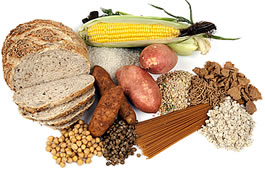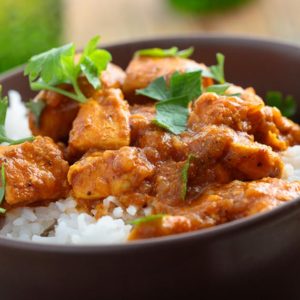The main aim of eating is to provide the body with enough fuel for activity. For this reason it is important to ensure that what you eat is going to provide that fuel.
Energy is measured as kiloJoules (kJ) or calories. Where a capital ‘C’ is used for Calories this indicates 1,000 calories.
Food is made up of a number of macro nutrients which all provide energy. Some are more useful than others.
Carbohydrates are the most important as they provide the most readily available energy and will be covered in more detail below.
Fat provides the most abundant energy, but as even a very skinny person has more than enough fat stored on their body you don’t need to focus on consuming extra fat to supply yourself with energy.
Protein is important to consider as it plays a vital role with recovery and repair. Its contributions energy wise are minimal and therefore don’t need to be discussed in detail as part of your event nutrition.
Carbohydrates can deliver both long and short term energy which is going to be critical whether you and your team are doing the three or the nine hour event. Each gram of carbohydrate delivers 16kJ of energy. Once ingested by the body, it needs to be broken down and absorbed into the blood stream. The bigger and more complex the carbohydrate is, the longer this process takes. Once in the bloodstream this glucose (as that is what it gets broken down to) can then be used by a muscle as energy to contract and move you closer to the finish line. Muscle can use carbohydrate reasonably quickly. If it runs low on blood glucose it will need to rely more heavily on fat, which is a slower process and means you can’t move as quickly as your upper limit of exercise intensity will be lower. This might sound like a great way to burn extra fat, but when your body is using carbohydrate in conjunction with oxygen it will also be burning fat simultaneously already. Changing the focus primarily to fat will inhibit your performance and be a lot slower.
 Carbohydrates basically come in two types (technically this is not correct, but for the purposes of this discussion it is close enough). Carbohydrates that provide slow release energy are known as low GI. In contrast to this, quick releasing carbohydrates, known as high GI foods, give you a quick shot of energy. These types of carbohydrates are great during or immediately after exercising.
Carbohydrates basically come in two types (technically this is not correct, but for the purposes of this discussion it is close enough). Carbohydrates that provide slow release energy are known as low GI. In contrast to this, quick releasing carbohydrates, known as high GI foods, give you a quick shot of energy. These types of carbohydrates are great during or immediately after exercising.
GI simply stands for glycemic index. The closer a food is to 100 the faster the energy is released. Glucose is 100 by definition. Food with values lower than 55 are generally considered low GI food and are great prior to exercising.
Another important consideration is hydration levels. Your body needs to be well hydrated to operate optimally. If your body is over hydrated it will simply take the excess fluid and convert it to urine. If you are optimally hydrated your urine will be clear in colour. If you are dehydrated your urine will be concentrated. If this is the case consume water until it turns clear. If you are utilising a multivitamin, your urine will be concentrated regardless of how hydrated you are as your body excretes surplus/excess vitamins your body doesn’t need.
Energy drinks are very popular these days, but not at all suitable for exercise. Carbonated drinks like Red Bull or V do not go too well with exercise as the fizziness can cause stomach problems during exercise. Suitable products can often be purchased in powdered form and mixed with water before consuming. These products work best when mixed to create a drink with a concentration of 6-8% carbohydrate. This will aid quick absorption out of the stomach. For this reason it is important to mix to the manufacturer’s recommendation. Too high a concentration in your gut can cause you problems and can in fact dehydrate you. Too low a concentration and it will be ineffective in its job. Popular products include Balance Endurance, Leppin Endro, PowerAde and Gatorade.
You can also purchase little squeeze packs of concentrated carbohydrates which you simply rip open and suck the contents down for a quick high GI hit. These products are great, but you have to consume them with water. Basically instead of mixing a powder with water in the bottle you are mixing a concentrated liquid with water inside your stomach. The same issues can occur if the carbohydrate is too concentrated in your stomach.
Prior to the Event
 The night before you and your team do the Spring Challenge you need to load up on carbohydrates. This is often referred to as ‘carbo loading’. You should aim to consume a meal largely made up of low GI carbohydrates. Use pasta or rice for the base of the meal with a low fat topping for the rest of the meal. Ideas include pasta with a vegetable based sauce or maybe a chicken or vegetable curry (especially if it includes kumara or potatoes). This type of meal will enhance your body’s stores of carbohydrates. To enhance your body’s storage of these greater stores of carbohydrates your body will require three grams of water for each gram of carbohydrate, so ensure you drink plenty of water as well. Alcohol will inhibit this process and should be avoided with this meal.
The night before you and your team do the Spring Challenge you need to load up on carbohydrates. This is often referred to as ‘carbo loading’. You should aim to consume a meal largely made up of low GI carbohydrates. Use pasta or rice for the base of the meal with a low fat topping for the rest of the meal. Ideas include pasta with a vegetable based sauce or maybe a chicken or vegetable curry (especially if it includes kumara or potatoes). This type of meal will enhance your body’s stores of carbohydrates. To enhance your body’s storage of these greater stores of carbohydrates your body will require three grams of water for each gram of carbohydrate, so ensure you drink plenty of water as well. Alcohol will inhibit this process and should be avoided with this meal.
Prior to race start
On the morning of the event you need to consume an energy dense, nutritious meal to top up your carbohydrate stores from the night before. You will also need to consume fluid to ensure your hydration level is optimal. Suitable suggestions include:
- Muesli with low fat milk or yoghurt
- Fresh fruit salad
- Banana on multigrain toast
Between breakfast and the race start continue to top up your hydration level. Drinking an energy drink can assist with topping up energy levels in conjunction with hydration levels at this point.
During the event
Maintaining your energy and hydration levels is the main focus of your nutrition whilst exercising. During an event that is over a period of many hours it is important to ensure in the latter stages of the event that you are getting enough slow release energy. Relying on sweet commercial sports products for hours on end is not for everyone, so consider some real food as part of your plan.
During the event I would recommend drinking a small amount of fluid regularly. A sip or so every 15 minutes of either an energy drink or water will ensure your hydration levels are met. However if the conditions are hot (not what is expected at Spring Challenge), this will not be sufficient and therefore utilising two drink bottles, one with water and the other with an energy drink should be considered. Alternate between the two bottles to ensure enough energy is consumed.
Simple to eat high energy products such as muesli bars, dried fruit etc. can be consumed regularly every 30 minutes. Having high GI items such as jet plane lollies on hand can give you a quick boost when you need it and can truly be life-savers when your blood glucose takes a dip.
Each time you return to a Transition Area (TA) is the perfect opportunity to top up with longer lasting low GI food that also tastes great. Simple ideas such as sandwiches, quiche etc. can be grabbed as you start running or biking towards the next TA.
When I worked for an American based Adventure Racing team participating in the six day Southern Traverse AR in the early 2000s, I had four Big Macs delivered into the Southern Alps as a special treat. That was a big morale booster for them all.
Post Event
After the event it is time to celebrate your achievement and I won’t take that reward away from you. But prior to celebrating I would encourage you to ensure that you are fully hydrated and have replaced your blood glucose. The body’s ability to absorb carbohydrates is greatly enhanced post exercise. This quickly diminishes, so it is important to take advantage of it by consuming a mix of both high and low GI foods. It is also important to consume some form of protein. This is important for both repair and recovery. The optimal ratio is 4:1 carbohydrates to protein. Don’t get too pedantic about this. Simply consume some protein after the event.
This is the basic outline for suitable nutrition during an AR such as Spring Challenge. Good luck with your event in September and incorporate as much of this into your training prior to the day.
If you would like some yummy and healthy recipe ideas check out the Chef Ray section of my website. http://www.coachray.nz/category/chef-ray/
Get my one of my Spring Challenge Training Plans through Training Peaks. Results Guaranteed. Purchase here. Use discount code CR15 to get a 15% discount.
https://www.trainingpeaks.com/my-training-plans/qwik-kiwi-coaching-adventure-plans
